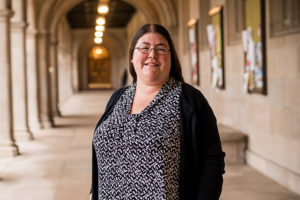As human lifespans have gotten longer, certain proteins in our bodies are increasingly prone to take on alternative shapes. These misfolded proteins can ultimately trigger neurodegenerative diseases such as Alzheimer’s, Parkinson’s and Lou Gehrig’s disease, formally known as amyotrophic lateral sclerosis (ALS).

Meredith Jackrel, assistant professor of chemistry in Arts & Sciences at Washington University in St. Louis, is developing strategies to make cells better able to deal with these devastating diseases. Jackrel recently received a five-year grant from the National Institutes of Health (NIH) and another from the Longer Life Foundation to study protein disaggregases — evolved protein forms that mitigate protein misfolding — as a strategy to combat these diseases.
Her lab is exploring several naturally found protein disaggregases in hopes of engineering them to improve upon their capabilities.
A protein in yeast known as Hsp104 caught Jackrel’s attention during her postdoctoral studies. She and other researchers knew that yeast contained this protein to regulate prions, another word for misfolded proteins. They figured that if it could do this in yeast, then maybe it could work on the misfolded proteins that cause neurodegenerative diseases in humans.
“We figured out that Hsp104 can disassemble many different neurodegenerative disease-associated proteins. We also used protein engineering to develop a form of it that dissolves many different aggregated proteins such as TDP-43 in ALS and α-synuclein in Parkinson’s. Now the thought is that it can dissolve others,” Jackrel said.
Since this protein is found in yeast, plants and other microbes, but not in animals, harnessing its potential for human use is a tall order. But researchers think there may be human proteins that could be employed in a similar way.
Read more about the work in the Ampersand.
